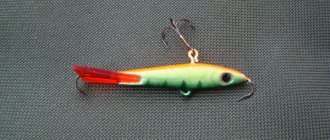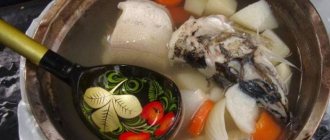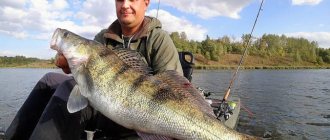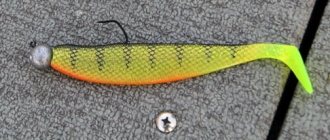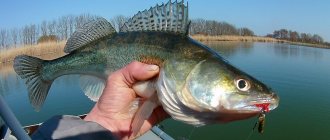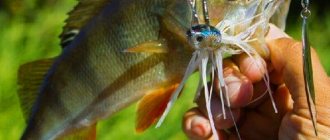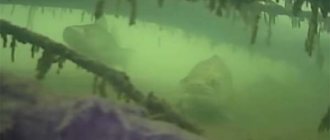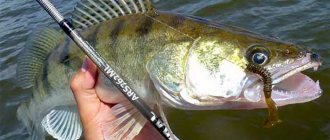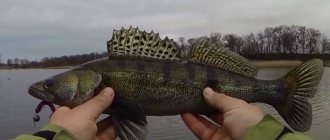Size
To hunt fangs, it is recommended to take elongated, narrow-bodied vibrotails with a length of 50 to 150 millimeters. It is better not to use massive baits due to the structural features of the predator’s mouth. He is not able to swallow a large bait.
For medium and large pike perch, vibrating tails with a length of 100 millimeters or more are preferred. But often the fanged one does not react to such sizes, while it actively bites on compact rippers (50-70 millimeters). This especially happens with a passive predator, motionless in a shelter.
When choosing a silicone bait for fanged fish, it is extremely important to consider the size of the potential trophy. If there is a large pike perch in the reservoir, then a vibrotail of appropriate size should be used.
In winter, pike perch catches better on small vibrating tails.
You should experiment with the length of the bait during the fishing process, as the predator can change its preferences. That is why it is important to have a rich arsenal of baits of various sizes.
Examples
There are several mass-produced silicone baits that have already earned recognition in the fishing community.
Tioga 100
This is a fairly large twister, 100 mm long. It is good for medium and large pike perch in almost any body of water.
LONG JOHN 07.90/PA03
A flavored vibrating tail that perfectly imitates a small fish when pulled evenly. Available in the scent of mackerel, crab, etc.
DEEP PEARL 100
An effective vibrating tail in the shape of a large fry. The greatest effectiveness when using it can be achieved with the help of various attractants.
Form
As mentioned above, silicone for pike perch should have an elongated shape. In addition, it is not advisable to use vibrating tails with various vibrating fins and other noise effects. A vibrotail is needed that is as similar as possible to the natural prey of pike perch living in a given body of water. Both in form and behavior.
Preference should be given to vibrating tails made of hard material, otherwise the tail of the bait often gets stuck when moving. This fact negatively affects the brightness of the vibrotail's play.
Experienced zander fishermen have discovered a pattern that in spring and summer, elongated vibrotails with narrow tails are more catchy, and closer to frost, pot-bellied baits are preferable.
Silicone baits for catching pike perch
silicone vibrotails
Pike perch is never indifferent to rubber products and actively bites on them.
Various twisters and vibrotails are very catchy baits when fishing for pike perch. This fish has its own individual “requirements” for the size of the silicone, its color, shape, weight and smell.
In the summer, on days when pike perch are passive, good results can be obtained by using flavored silicone. The smell of fish and shrimp can awaken a ravenous appetite in this predator and bites will follow one after another.
The size of the vibrotail is always small; this fish prefers to eat food in small portions.
Twisters or vibrotails with a length of 20 - 50 mm are the most catchy for catching pike perch.
When fishing for pike perch in winter, silicone fish are selected in such a way that the size of the vibrotail is as small as possible.
Wiring at this time is radically different from summer wiring and is carried out with significant pauses.
Edible silicone
The edibility of vibrotail does not play a key role when catching active fish. But the fragrant smell can provoke a passive pike perch to attack. But the main advantage of edible rubber is that the predator grabs the bait more confidently and does not immediately notice the catch. In addition, pike perch are characterized by “quiet” bites, when it only slightly grabs the bait. In this situation, the edibility of the vibrotail will allow the fanged one to hook it more reliably.
Edible baits may contain salts and attractants, or they may simply be impregnated with flavorings. Favorite flavors for pike perch: fish, meat and shrimp. These smells can arouse a frantic appetite in him and attacks on the edible vibrotail will follow one after another.
You can buy flavorings in fishing stores and saturate the silicone yourself, making it edible. Abundantly soaked vibrotails, when moving in the water, leave a noticeable aroma that can not only provoke pike perch to bite, but also gather a flock of decent predators in the fishing area.
Catching pike perch with a jig. How to choose the color of the bait?
Today, the abundance of colors and shapes of silicone baits makes your eyes dazzle. But this article will focus specifically on color. Over the years of catching pike perch with jigs, some semblance of a pattern has developed regarding the choice of the most promising bait color depending on the fishing conditions, and these are the considerations I would like to share with the reader.
- “The main thing is not the color, but the presentation of the bait!” Such phrases are often found among jig fishermen, but, nevertheless, even those spinners who utter such phrases have a lot of “rubber” of different colors in their fishing scrap. This was the first reason why I wanted to delve deeper into studying this issue and consider whether there really is a relationship between the color of the bait and the number of bites.
For many years, I had to focus on little things, question not only the statements of experienced “horsemen” on this matter, but also double-check my observations on this matter. But one way or another, my conviction at this point in time is this: - the color of the bait increases the fishing efficiency and the number of “fanged” bites! Moreover, in some moments, color is even more important than shape or size. But how to choose the right color in the shortest possible time? How can we immediately determine the most promising color on a specific day and what natural phenomena and seasons should this be “linked” to? These questions do not leave me to this day, but I still managed to notice some stable patterns, and we’ll talk about them.
Let me start with the fact that when catching pike perch with silicone, from the entire spectrum and contrast of colors I was able to identify the following: poisonous green, green, dark green, machine oil, red, carrot, white, black, and variations of these colors. But most often, for some reason, poisonous green, dark green and “car” work for me.
In the spring, while the turbidity in the reservoir has not yet completely settled, it is preferable to start fishing with brightly colored baits - poisonous green and white. But it’s worth mentioning separately about white; for pure white baits, like the “relax” one shown in the photo, bites are rare. White baits interspersed with black dots or those with a contrast of two colors work best, for example, white body + red tail, or white bait + red back. The requirements for green colors, as for many others in fact, are one - it is better that the baits are made of transparent silicone, although this has nothing to do with red and black colors.
I rarely use pure red (carrot) color silicone. These are mainly variations: red + black, red + green. Such baits perform very well in sunny weather and calm water in early summer. At the same time, dark green colors and their combinations with red can appear. Somewhere in mid-June - early July, the water on the Kama and Volga begins to bloom, and the lower the river flow in the fishing area, the less transparent it becomes due to the abundance of single-celled green algae. Here, it would seem advisable to again turn to the help of the brightest colors, but most often the same dark green “Mance Predator” with a red head or tail works, and also, contrary to logic, the “machine oil” color starts to work. For a long time I could not understand why this was happening, but it turned out to be quite simple.
During this period of time, crayfish moult in our region, and, as you know, crayfish in a new shell is a simple, and most importantly very tasty and desirable prey for the entire perch family. The new shell will get stronger only 10-12 days after molting, so all predatory inhabitants of water bodies, even the crayfish themselves, hunt crayfish. You ask, what does hunting for arthropods and the color “machine oil” have to do with it? The crayfish has the same color after molting, that's the trick! Therefore, I made it a rule during this period of time to start with a “typewriter” or dark green color with black splashes. If these colors do not work, then you need to switch to brighter or sharply contrasting colors, for example, white and blue colors.
Sun, cloudy, ripples, waves, depth, in the middle of summer.
The depths in the places I often visit are approximately the same. These are slopes and edges from 3-4 meters to 12-16. In clear sunny weather, even with a good wave, I start fishing with a “machine”. If the pike perch is at the bottom of the drop-off and reacts poorly to a bait of this color (“butts”, pokes), then I immediately put in a brighter one, for example, “lemongrass” or “acidgrass”, or their variations. Why contrasts of colors on one bait often work, I don’t have an exact answer, but I can assume that the pike perch does not see a darker color at depth, or does not see it clearly, so the sicaraga seems to him to be much smaller in size than it really is, and he can easily catch up with her and devour her. The situation is the same in cloudy weather, with a fairly strong wave. Although pike perch is a nocturnal predator and has excellent eyesight, it doesn’t hurt to help it with bright colors or contrast even during the day.
In autumn, nature begins to prepare for hibernation, the behavior of all aquatic organisms changes. Single-celled organisms die off, the water cools down, becomes more transparent, and in some places, especially in late autumn, even crystal clear. Catching pike perch with silicone in such conditions becomes more difficult, but, nevertheless, sometimes it responds well to dark-colored baits. Contrasts of black and red colors work great; black and yellow; black and dark green. Therefore, you need to start with these colors, and it is better to use baits with a less pronounced game, such as foam rubber or buoys, but maintain your color preferences.
In conclusion, I would like to note that everything written is just my observations; they may not coincide with someone else’s experience and opinion for various reasons. In addition, no matter how I start fishing with a bait color that is more suitable, in my opinion, there is no template! Sometimes it happens that black color works even at night, but white or luminescent pike perch shy away like crazy. The main rule of any fishing remains search and experimentation, and the rest is given as a percentage from worst to best. In general, fish don’t give a damn about our opinion, and advice is not an impetus for action, but only a reason for thought and food for thought. If it helps someone, I will be only glad!
NHNCH!
Color
The color of the vibrotail does not play a major role on pike perch. Even bright acid colors cannot tempt a passive pike perch to attack the bait. And with a good bite, the predator grabs vibrating tails of any color almost indiscriminately.
However, this characteristic of the vibrotail should not be completely neglected. There are still certain patterns in color:
- bright colors are effective in warm and slightly turbid water at a depth of no more than five meters;
- at depths greater than 5 meters, as well as in the absence of sun, fluorescent rippers are preferred;
- for sunny weather, silver baits are suitable;
- in the rain, pike perch responds better to silicone of carrot and yellow colors;
- Dark and marshy colors of the baits are ideal for cold water.
Since it is impossible to predict the color preferences of pike perch in advance, it is highly advisable to have rubber of different colors in order to be able to please the fanged one.
Types of silicones
Currently, several types of silicone baits are used in pike perch fishing:
- vibrotails;
- twisters;
- slugs;
- worms;
- creatures.
When choosing a silicone bait, you need to take into account that the pike perch has a small mouth, and it is accustomed to feeding on small oblong fish. Therefore, the rubber must correspond to the shape familiar to the predator. Large baits are best left for pike, which have a correspondingly huge mouth.
Vibrotails
Most often, spinning players use the first two types of rubber. The vibrotail for pike perch is an oblong fish with a flat tail - heel. When moving, this element creates longitudinal vibrations that attract fish.
To catch pike perch, narrow-bodied vibrotails are used that imitate the main food of fish: bleak, sprat, roach.
Twister
The second most popular bait for pike perch is the twister: an oblong elastic band with a sickle-shaped movable tail. The vibrations it produces are more frequent and radially directed. As with the vibrotail, narrow-bodied lures are the best.
The ribbed body of the bait allows it to behave more realistically when retrieved.
This is interesting! Many fishermen successfully use twisters on a jig head when fishing for pike perch from the ice in winter. They often surpass both balancers and vertical spoons in terms of catchability.
Others
Other types of silicone are most often used when the fish is inactive and capricious. It is at such moments that she is offered various fantasy options.
Variety of fishing silicone. Try to guess what the fanged one will like today.
Installation of vibrating tails and wiring for fishing pike perch
The fanged predator is usually caught on silicone in the bottom layers, using such techniques as dragging along the bottom, tapping on the bottom and the classic step. Winter fishing for pike perch using vibrotails is characterized by longer pauses during retrieval compared to fishing in warm water.
Possible installation methods:
- articulated (with “Cheburashka”);
- classic (with jig head);
- paternoster.
For cluttered places and in thick algae, it is useful to use non-hooking ones, recessing the hook inside the vibrotail.
You should be especially careful when choosing a hook. Firstly, it must be suitable in size for the vibrotail. The size of the hook should be equal to half the length of the vibrotail. It is inserted into the bait at an angle of 30 degrees, and the sting is brought out from the back. In this position, the vibrotail will not lose its properties in the water, it will create enough vibrations and will not fall off the hook.
Secondly, it must be extremely sharp, especially when using narrow-body vibrotails. When inserted, a dull hook can simply damage the vibrotail, plus the number of derailments will noticeably increase.
TOP 5 silicone baits for pike perch
Bugsy Shad 72
This vibrating tail is used for catching trophy pike perch.
The model is made of edible silicone and has a mackerel aroma. To make such a catchy bait, the highest quality material is used.
The vibrotail can be used in various types of equipment, including as a jig bait with a classic jig head. Trophy pike perch are caught on this type of bait early at dawn.
When using Texas equipment, this type of bait is used with minimal loading, which allows the bait to provide an attractive game.
Tioga 100
This is a twister, with a body length of about 100 mm, so the model is intended for catching exclusively large individuals and pike perch is no exception. The bait has a good action and is very catchy, especially when used in a Texas rig.
Ballist 63
The model is a hybrid of a twister and a worm. When moving in the water column, it is more reminiscent of the movements of a leech. In cases of stepwise fishing, the pike perch becomes partial to this bait. When making the bait, edible silicone is used, which has a shrimp aroma.
LONG JOHN 07.90/PA03
The model of this silicone bait exudes the aroma of mackerel, so it actively attracts large predators. When the bait moves in the water, it imitates the movements of a fish. Often, pike perch does not ignore this bait if it moves in the water column.
DEEP PEARL 100/016
This bait is quite large in size, but this allows you to catch trophy specimens. The model is made of ordinary silicone, so it does not have its own scent. In this case, you can use attractants whose aroma matches the aroma of fish, shrimp, mackerel, etc.
Choosing a weight for catching pike perch using vibrotails
In addition to choosing the right vibrating tail and the method of its installation, it is extremely important to select the correct weight of the load for it. Zander fishing in quiet, shallow places without or with little current involves the use of a weight weighing 10 to 15 grams. For places with a depth of more than 8 meters, as well as in the middle reaches, jig heads weighing 16-25 grams are suitable. In rivers with strong currents, all loads can exceed 40 grams. The optimal weight must be selected experimentally.
In shape, as a rule, they take classic jig heads, as well as lentil and bullet-shaped ones. Bullet weights have excellent flight characteristics, which is why they are used for long casts. Weights for mounting a ripper on a pike perch can be soldered into the hook or attached separately.
How and where to catch
As you know, pike perch lives in the bottom layers of water bodies with currents. He loves to stand in holes, near snags, waiting for his prey. Based on this, the most effective equipment for catching it using silicone baits appeared, differing in their installation. The most famous among them:
- Classic equipment.
- Hinged mounting.
- Various variations of spaced equipment.
Which one suits you better than the others can only be found out in practice by fishing for some time with each.
Classic , or as it is also called, stationary equipment is based on the use of well-known jig heads with a hook fixedly attached to the lead head. Despite the limited mobility of the bait with this installation, it shows very good results. Especially when using large sizes of silicone.
Hinged mounting is characterized by the fact that the hook on which the bait is located and the weight (head) are secured to each other using a ring or carabiner. This ensures a certain freedom of movement for the silicone, which has a positive effect on its catchability during certain animations.
In recent years, pike perch have been increasingly caught using silicone baits using spaced rigs . This is for example:
- A rig called “Carolina”. Its difference is that the streamlined weight is fixed 10–15 cm above the hook. During animation, it periodically comes off the bottom and raises the mud, which additionally attracts fish. It is intended for areas of the reservoir with a clean bottom.
- "Texas" equipment. It is very similar to the “Carolina”, but differs in that the weight in it is used in a teardrop shape and is movably attached to the main cord. The stopper, which limits its movement, is fixed approximately 20 - 30 cm above. When installing the equipment, the load is placed with a narrower part towards the rod, this ensures its increased permeability through overgrown areas of the reservoir.
- Equipment with a retractable leash. The weight is attached to the end of the main cord, and a thinner leash, using a swivel, is 20 - 25 cm higher. Fishing with such equipment is usually done from a boat at great depths. It is possible to use medium-sized silicone.
It is important to remember that each rig requires a specific wiring technique. The most famous and most common is jerk fishing, which periodically lifts the bait from the bottom and moves it a certain distance towards the rod. Rising clouds of turbidity in combination with the work of silicone almost always attract the attention of a fanged predator.
The best vibrating tails for pike perch
Let's consider the rating of the best zander vibrotails.
Lucky John Bugsy Shad
The first place in the rating of vibrating tails for pike perch goes to Shad from Lucky John. Excellent edible silicone with the taste of mackerel or mackerel is very popular with pike perch. The classic shape of the vibrotail is combined with the presence of a large number of legs located on the sides along the entire length of the bait from head to tail. Quite often you come across truly trophy specimens. Characterized by bright play with any type of wiring. Suitable for any equipment, but it performs better than others with the Texas one, while the shipment of the bait itself should be extremely small.
Keitech Easy Shiner
Easy Shiner is an edible vibrating tail with a traditional shape. The thin tail has a large blade, and the body is flattened on the sides. The bait was designed for offsets, as evidenced by the presence of grooves on the top and bottom. A key feature of the Easy Shiner is its low center of gravity, which ensures a stable position of the ripper when moving and no roll. In addition to asymmetry, salt is used to weight the lower part of the vibrotail. The vibrating tail is effective for various installation options. Easy Shiner silicone is not particularly durable.
Lucky John Pro Series Tioga
Tioga is a vibrating tail with a mackerel scent, designed specifically for catching pike-perch and perch. It has a worm-like body and a compact, hoof-shaped tail. When moving, it shows an unsurpassed game, attracting a predator. Large specimens are often found on Tioga. The optimal equipment is Texas.
Pontoon 21 Awaruna
Awaruna is highly durable and has a recognizable aroma. There is a hole inside the body that allows it to be used in combination with a jig head and a double. The vibrating tail fits perfectly evenly. There is a groove on the back that can hide the sting of the offset press. Also, this vibrating tail is suitable for hinged mounting, in this case Awaruna moves not only the heel, but the whole body.
Keitech Swing Impact
Swing Impact is the most popular lure of the Keitech brand. It has no equal in terms of the number of copies. The shape of the body is combined with various types of installation. A unique flavoring impregnation is contained not only on the surface, but also inside the silicone, which makes it truly edible. The recommended size for walleye is 4 inches. Among the minuses, it is worth noting that silicone is very delicate and soft; the heel of the vibrotail especially often breaks.
Relax Copyto
Relax Kopyto is one of the most legendary rippers of our time. It features an outstanding range of sizes and colors. There are a huge number of different sparkles on the body of the vibrotail. Durable and tenacious silicone that can withstand pike perch attacks. The bait does not have edible properties. Optimal installation is on a double hinge.
Lucky John Long John 07.90/PA03
LONG JOHN 07.90/PA03 is a catchy bait with an elongated body. In the water it wriggles very temptingly on the hook. Plus the attractive smell of mackerel. The vibrotail is not picky about the type of equipment. A chic selection of colors allows you to choose the optimal color for any fishing conditions. Many fishermen call this bait a pike-perch “killer” and they are not mistaken in this, since pike-perch bites on it with enviable consistency.
Reins Bubbling Shad
Reins Bubbling Shad is a classic ripper for large walleye. The oblong body has a ribbed surface and a small hoof. Silicone is moderately soft, but at the same time resistant to predator attacks. With intense movement, it emits original vibrations, accompanied by a trail of bubbles. The bait contains highly stable flavors. The color palette is more than decent: more than 30 colors.
Pontoon 21 Ratta
Pontoon 21 Ratta is the best bait for pike perch in the spring. Outwardly it resembles bleak or roach. The material from which the vibrotail is made includes edible components. Silicone is elastic, but moderately durable. The variety of colors is extensive and very diverse. Works great on the slowest wires. The best installation is hinged with offset.
Yum Money Minnow
Money Minnow closes the top ten. The vibrotail has a realistic appearance. The shape is standard, the body is slightly elongated. It is made of soft, high-quality material, so the slightest movement of the rod ensures an intricate play of the vibrotail. Especially catchy in cold spring or autumn water. It is recommended to use a classic rig with a jig head.
- Silicone baits for pike perch
- Color of silicone lures
- Molding silicone baits
- The best silicone crustaceans: TOP 5
Content:
- 1 Silicone baits for catching pike perch
- 2 TOP 5 silicone baits for pike perch 2.1 Bugsy Shad 72
- 2.2 Tioga 100
- 2.3 Ballist 63
- 2.4 LONG JOHN 07.90/PA03
- 2.5 DEEP PEARL 100/016
- 3.1 Texas rig
Modern silicone baits in appearance, as well as in their performance in the water column, are practically no different from live fish. The thing is that this material is quite flexible. In addition, silicone baits smell the same as live fish if they are made with fragrances.
